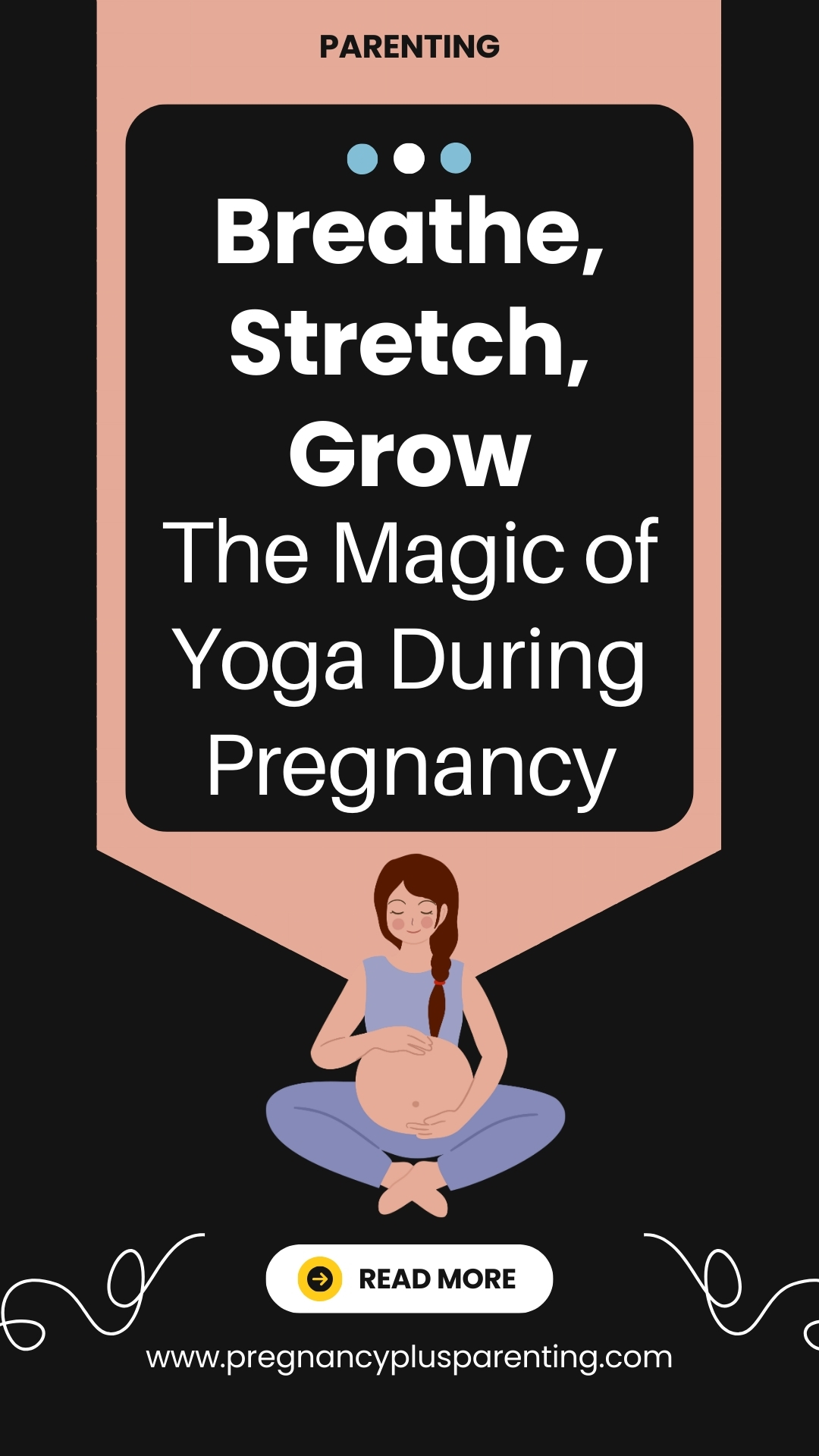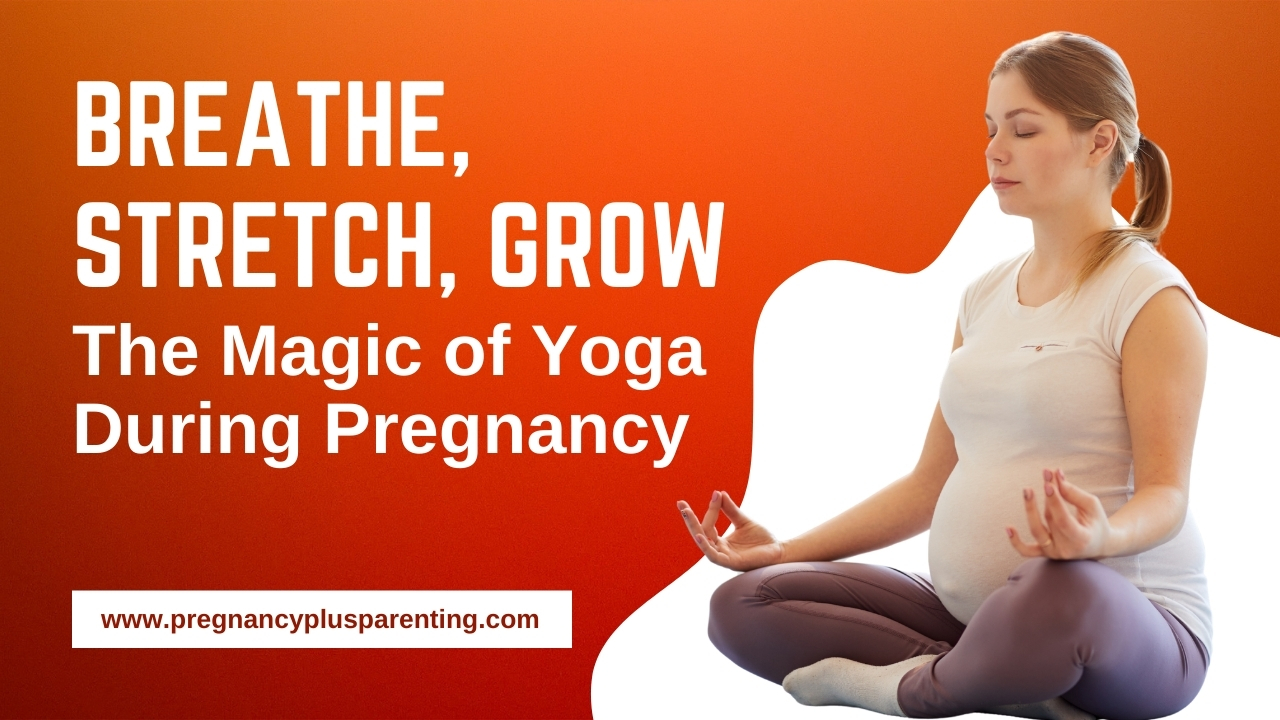Breathe, Stretch, Grow – The Magic of Yoga During Pregnancy
Pregnancy yoga is good for relaxation, increasing mindfulness, and gaining strength. But what exactly is yoga, why do so many people rave about it, and how can practicing yoga during pregnancy benefit you and your baby?
Which types of yoga are particularly suitable for pregnant women, and what is prenatal yoga? Is there any truth to the claim that pregnancy yoga helps with pregnancy-related discomfort ?
Will it also make childbirth easier? Is yoga even suitable as birth preparation? What’s the difference between yoga and prenatal exercises or Pilates?
And if I decide to do prenatal yoga, will my health insurance cover the costs? In this article, I’ll answer all of these questions for you.
Pregnancy yoga – welcome movement during pregnancy
Can you imagine that there was a time when pregnant women were generally discouraged from exercising? Fortunately, those days are over, and both insight and attitudes have changed.
It doesn’t necessarily have to be sport, but sufficient exercise is definitely good for both the expectant mother and the baby.
According to a study by the Cologne Sports University, exercise reduces the use of painkillers and even the risk of postpartum depression.
It’s clear – if you get enough exercise, you not only feel fitter, but also more balanced, can sleep better and more deeply and have fewer physical complaints such as back pain.
Pregnancy yoga – What is yoga and what types are there?
If you’ve never practiced yoga before, you probably imagine well-trained people contorting their bodies into all sorts of poses and positions on mats, perhaps even wearing tight sportswear.
And terms like Kundalini, Ashtanga, Hatha and Pranayama make your head spin and perhaps even have a religious connotation for you?
No, yoga is neither a sport nor a religion, but a two-thousand-year-old Indian discipline in which physical exercises actually represent only a fraction of what yoga is about.
So, if you think you have to be a great athlete to do yoga, I can reassure you. That’s not the case.
Just as yoga comes from India, the word has its origins in Sanskrit and roughly translates to “harmony” and “unity.” It’s actually suitable for everyone, and the strange terms I mentioned above represent different variations or styles.
You choose the style that suits your type and health condition. But what do all styles have in common?
Yoga helps to develop a better body awareness by exercising the muscles, paying attention to breathing and strengthening the cardiovascular system.
Yoga is certainly also a sport and with regular practice you lose weight and there are also positive toning effects, but yoga is more about the attitude to life, which improves physical as well as mental and spiritual health.
Yoga promotes relaxation, patience, and mindfulness—toward oneself, others, and the environment. It’s about understanding and expanding.
Physical exercises called asanas help achieve this. Asanas enable long-lasting meditation and conscious awareness of the body. Yoga is described in a teaching from the 5th century as a path consisting of eight stages, which are:
1. Yama: Code of conduct and moral discipline
2. Niyama: Self-control
3. Asanas: physical exercises
4. Pranayama: breathing exercises
5. Pratyahara: the mind is directed inward
6. Dharma: Concentration on morality and ethics
7. Dhyana: spiritual immersion through meditation
8. Samadhi: State of enlightenment
The difference between yoga, Pilates and gymnastics
As you can see, there’s a whole philosophy of life behind yoga. The additional focus on breathing techniques distinguishes yoga from stretching exercises like those you’re familiar with from gymnastics.
And while Pilates’ primary goal is to strengthen muscles, yoga is even more about the mind. Pilates originated in the 20th century and is therefore much younger than yoga, where it awakens energy in the core of the body and in the arms and legs.
Even though Pilates is not a competitive sport, it can be quite strenuous for beginners to perform the precise movement techniques that strengthen the muscles.
And then there’s Yogates. This, as the name suggests, is a blend of yoga and Pilates. Typically, you start with easier asanas, move on to more challenging Pilates exercises, and finish with gentle asanas again.
But let’s get back to yoga and look at what yoga styles there are
1. Ashtanga Yoga
In this style of yoga, the exercises always follow the same order. Throat breathing is central to the breathing technique, and demanding asanas require the muscles to work hard. Ashtanga Yoga is based on the eight-step path mentioned above.
2. Hatha Yoga
This style of yoga is ideal for beginners because the physical exercises are easier to perform and the breathing technique is more relaxed. This is the classic style of yoga, which is what most people think of when they think of yoga, but aren’t very familiar with it.
Hatha Yoga gently introduces yoga philosophy, focusing more on the mind than on the body.
3. Kundalini Yoga
In this style of yoga, particular attention is paid to breathing. Intensive breathing exercises are intended to consciously direct the prana, or life energy. Furthermore, the Kundalini style makes more intensive use of mantras. The spiritual side of the human being is clearly the focus here.
4. Yoga Nidra
This is a special style of yoga in that it gives full space to the spiritual. The goal of the Nidra style is to enter a trance-like state, as if on the border between waking and sleeping.
The thoughts and feelings that arise should flow freely and not be judged. Meditation plays a crucial role here.
5. Power Yoga
Although this style of yoga is based on Ashtanga Yoga, the sequence of physical exercises is flexible. The asanas may not look as strenuous, but anyone who has tried it knows that you’ll quickly work up a sweat and get out of breath.
The deep muscles are used and strength, coordination, balance and breathing are strengthened.
6. Vinyasa Yoga or Vinyasa Flow
The main difference from other yoga styles is that the asanas flow seamlessly into one another, guided by the breath. The sequence of asanas is repeated at a fairly rapid pace, with the emphasis not only on developing breathing but also on building and strengthening muscles.
7. Yin Yoga
This very relaxed style of yoga is designed to hold the asanas for several minutes. The goal is not to harness and develop strength, but rather to enhance the stretching effect and to listen carefully to yourself during this time.
So if you want to take it easy, strengthen your joints and relax your connective tissue, this style of yoga is recommended.
Pregnancy yoga – prenatal yoga and other yoga classes
Now, of course, it makes a difference whether you want to consider a regular yoga class or whether you are thinking about pregnancy yoga or prenatal yoga.
It is important to know that some yoga teachers refuse to teach pregnant women for legal reasons.
So, you should definitely check with your yoga teacher to see if you can participate while pregnant. Basically, any experienced yoga teacher will be able to guide you and offer you certain alternatives if they’re willing.
Pregnancy yoga differs from traditional yoga in that it is slower and gentler. It also avoids certain physical exercises, or asanas, that could be dangerous or harmful to you and your baby.
For example, there are no prone exercises or abdominal exercises in prenatal yoga. There are no inversions like shoulder stand or headstand in the yoga class, and no jumping is involved.
My recommendation is that you sign up for prenatal yoga, even if you’ve already attended a yoga class. It’s not a style in itself, but rather a blend of asanas that are particularly beneficial for your condition.
If you can’t find alternatives to the asanas you have to skip in traditional yoga, then the flow is disrupted and you might even suddenly feel uncomfortable with your baby bump.
Pregnancy yoga also allows you to enjoy the company of other pregnant women and exchange ideas.
Whether you choose a traditional yoga class or pregnancy yoga, you should be aware that not every style of yoga is suitable for pregnancy.
Power yoga is not suitable for pregnant women due to strenuous physical exercises that target the deep muscles.
Ashtanga Yoga and Vinyasa Flow are also not suitable for pregnancy due to the powerful and demanding asanas.
In addition, Pilates and Yogilates are not suitable for you as a pregnant woman, as these are mainly about exercising the muscles.
Kundalini yoga is definitely recommended, because with its beneficial physical exercises, mantras, breathing exercises and focus on meditation, this style is particularly well suited to preparing you for labor and birth.
Pregnancy yoga may be a little less demanding when it comes to building endurance and discipline, but it’s not about pushing yourself to your limits.
Your body awareness changes with each trimester anyway. The goal of yoga should be to train this awareness process.
Why is pregnancy yoga good?
Pregnancy yoga isn’t a competitive sport, nor does it offer a so-called athletic kick. Rather, it’s gentle movement combined with relaxation and a path to introspection and connection with your own body.
So if you are used to jogging or aerobics, you will certainly not find pregnancy yoga a suitable substitute.
However, yoga also releases endorphins, which provide pain relief and the so-called high when you feel comfortable during the asanas.
By the way, don’t be misled if I say that yoga is relaxing, because it can also be strenuous.
Nevertheless, the main thing is not to get out of breath during prenatal yoga, because if the oxygen is directed too much to the muscles, the baby in the womb gets less of it.
Pregnancy yoga means that you develop sensitivity for your own body and, with the breathing exercises, are actually better prepared for the process of birth.
It’s about finding your own pace and taking care of both your body and your mind.
Prenatal yoga can significantly reduce stress and also help you better cope with it. In a yoga class, you’ll find peace and recharge the energy you need for yourself and your baby.
For which complaints is pregnancy yoga helpful?
Now you might be surprised to see the list of pregnancy-related symptoms that yoga can help with. It’s actually quite impressive.
1. Back
Your baby means additional weight for your spine, which is put under considerable strain, with the lumbar vertebrae being particularly stressed.
In certain asanas, for example those performed in the quadruped position, you shift your weight in such a way that the strain on your back is relieved and pain and tension can subside.
And there are also asanas that specifically strengthen the back muscles.
2. Pelvic floor
Pregnancy yoga encourages you to think about and feel your core. Did you know that the pelvic floor is a muscle?
And some asanas strengthen the muscles of the pelvic floor. When the connective tissue is very stretchy and soft, the muscles have to absorb more.
3. Gastrointestinal tract
Exercise stimulates your metabolism, which also has a positive effect on digestion. So, if you suffer from pregnancy symptoms like bloating or constipation, prenatal yoga can help relieve them.
4. Heart and circulation
The flowing and repetitive movements stimulate circulation, and the body receives a good dose of oxygen. If you suffer from symptoms such as dizziness or varicose veins, pregnancy yoga will definitely do you good.
5. Mind and Soul
The special breathing techniques combined with the physical exercises will help you become more balanced and calm. You’ll reduce stress and learn to cope with it better.
Yoga also influences your emotional stability. You become more familiar with your own body and approach the big event of birth with more calm.
When should I practice pregnancy yoga?
In principle, there is nothing wrong with attending a yoga class early in your pregnancy.
But please, now is not the time to get ambitious. Even if your belly isn’t bulging yet, listen carefully to yourself and skip the exercises you don’t feel comfortable with.
Some yoga teachers recommend starting a class between 12 and 20 weeks of pregnancy. This is especially true if you’ve never practiced yoga before pregnancy.
From the 16th week of pregnancy, many women’s energy levels drop significantly, and by the third trimester, expectant mothers are already under a lot of pressure, and many feel tired and exhausted. This is the time to take things slower and more gently.
Basically, there are no limits as long as you feel comfortable with the exercises.
You can also practice pregnancy yoga at home on your own. You’ll find many videos online to guide you.
However, a yoga teacher can correct you if it is not done online and you are in a group on site with whom you can also exchange ideas.
Pregnancy yoga – does health insurance cover the costs?
It is quite possible that your health insurance company will cover at least part of the costs if you have the course recognized as a preventative measure, for example against pregnancy-related problems.
However, if you are thinking about replacing the birth preparation course with yoga, I must point out that this is unfortunately not possible.
During birth preparation, you will learn what happens during birth and there are also breathing exercises, but pregnancy yoga involves the body.
Does pregnancy yoga make childbirth easier?
No one can promise that yoga will make labor shorter, easier, or less painful. But just as yoga can’t make stress disappear, it can help you cope better.
Many yoga teachers report that women who have practiced pregnancy yoga have dealt with the birth situation more confidently and mindfully.
The physical exercises and breathing exercises that you learn in the yoga class will definitely help you get to know your body better during labor and birth and not feel at the mercy of others.
One often hears that proper breathing is very helpful.
What should you keep in mind when doing pregnancy yoga?
The following tips are especially helpful if you plan to do prenatal yoga alone at home.
1. If you’ve never practiced yoga before, it’s best to start prenatal yoga at 12 weeks and take it slowly so you can build endurance. If you underestimate the effort and overdo it at the beginning, you may not practice regularly.
2. If you’re already advanced and very familiar with yoga, you should now lower your expectations and take it slowly and carefully. It’s best to practice the asanas you already know and not try anything new.
3. Pay attention to your body’s signals. If you get too out of breath or something hurts, stop the exercise and give yourself a break. As mentioned, yoga isn’t a competitive sport, and now isn’t the time to push your limits.
4. Since pregnancy hormones make your ligaments softer, it is especially important that you exercise your joints
Do not overstretch, as this could cause permanent damage.
5. Avoid lying on your back after the first trimester, and please avoid jumping and inversions such as headstands or shoulder stands, as there is a risk of injury. Lying on your stomach and abdominal exercises are also not recommended.
6. If you have any problems or discomfort during pregnancy, please ask your midwife or gynaecologist first if it is okay for you to do yoga.
Pregnancy yoga – 7 yoga exercises
Now I’ll tell you seven asanas that are very suitable for pregnant women. At home, all you need is a quiet spot, a mat or even just a rug that won’t slip, a yoga block if necessary, comfortable clothing, and, if you like, some quiet and soothing music.
1. Lotus position
This is a classic asana that’s often performed at the beginning of a yoga class. It’s best to sit on a yoga block.
It may look simple, but performing it correctly takes practice. To prepare, sit cross-legged with your knees bent and perform what’s known as a butterfly pose.
It is very important that your spine is completely straight, and a yoga block or a seat cushion can be useful for this.
To get into the half lotus position, place one heel against the perineum and take the other foot, turning the sole of the foot and placing it on the other thigh.
If your lower legs are crossed, you’re in the perfect lotus position. But if your knees feel painful, return to the cross-legged position.
Make sure to breathe regularly and deeply.
2. Child’s pose
To perform this asana, first sit in the heel seat and open your knees and feet wide enough so that your belly fits between them when you support your upper body on your elbows.
Place the yoga block, a pillow, or a towel in front of you so that you can rest your head forehead first on it between your outstretched arms.
As you breathe in and out deeply, you should now consciously perceive your shoulders, neck, arms and hands and keep your back nice and long so that it is relieved.
When you come back up, you should roll up very slowly and vertebra by vertebra.
3. Warrior
To begin, kneel on the mat or carpet and place one leg forward. Support yourself with your arms on the floor. The knee of the forward leg should be under your shoulders.
Now stretch your back leg up from the mat and place it so that the heel is across and you are standing stable in line with the front heel, which is pointing forward.
Place one arm on your thigh, turn your upper body and slowly stretch your free arm straight up while your gaze follows this hand.
Now let the arm sink back and stretch it straight while you straighten your upper body and stretch out the other arm as well, while your head points forward.
During this time, you should breathe calmly and try to make contact with your baby.
Now repeat this in reverse order and change sides.
4. Tree
This exercise helps you improve your balance while strengthening your shoulders and joints. Stand up straight and find a firm stance, with your feet slightly less than hip-width apart.
Now tighten your pelvic floor and find a point in front of you, which you fixate on with your eyes. It’s important that both your back and neck remain straight. Lift one knee outward and pull the heel up your leg as far as possible.
Once you’re standing securely, clasp your hands in front of your chest and slowly stretch them straight up above your head. Don’t forget to breathe. Then continue with the other side.
5. Cat-Cow
This exercise is also used in Pilates. For it, get into a quadruped position. Your arms should be extended directly under your shoulders, while your knees should be bent at a right angle under your hips.
As you exhale, your back should be straight. As you inhale, pull in your navel, tilt your pelvis, and move your spine upward so that your back resembles a cat’s. To do this, pull your chin toward your chest.
On your next inhalation, let your belly sink back toward the floor and pull your shoulders back, while lifting your head so your gaze is forward. Your back now resembles that of a cow.
As you alternate between cat and cow, pay attention to your breathing the entire time.
6. Diagonal Cat
Afterwards, you can immediately perform the diagonal cat pose from the quadruped position. Your legs should be hip-width apart again, and your hands should be shoulder-width apart.
Then extend your right leg behind you and raise your left arm forward. Your head should be positioned so that your chest, ears, and neck form a line while you look forward.
You can now push your left hand forward and your right heel backward, which will make it a little more strenuous for your back muscles.
As you inhale, lower your hand and leg, and as you exhale, raise them again. Then continue with the other side.
7. Deep squat
This exercise is designed to prepare for childbirth, as it opens the hips and relaxes the back. First, squat, place your feet apart, and knees to the side. Your heels should be completely flat on the floor.
Your hands should now be in prayer position, with your upper arms and elbows pushing your knees apart as far as possible. Your torso and back should remain straight.
If this isn’t possible, or you’re having trouble maintaining your balance, place a pillow or towel under your heels, or place your hands on the floor. Focus on breathing deeply while remaining in this pose.
Final thoughts
There was a time when exercise during and after pregnancy was considered inadvisable. Fortunately, this has changed, and studies have shown that exercise during pregnancy helps with pregnancy-related discomforts and can even help prevent postpartum depression.
Pregnancy yoga is enjoying increasing popularity and course fees can even be partially reimbursed by health insurance companies as a proven preventative measure, although a yoga course for pregnant women cannot replace a birth preparation course.
In this article, I explained to you what yoga is, why it is good to do yoga during pregnancy and how it differs from Pilates or prenatal exercises.
If you already practice yoga, you know that there are different styles of yoga, some of which are not so suitable for pregnant women.
Pregnancy yoga is not a separate style of yoga, but rather a mixture of different asanas or exercises that can be done safely during pregnancy.
If you are considering a traditional yoga class instead of pregnancy yoga, first find out whether the yoga instructor also teaches pregnant women.
As a beginner, you can generally start prenatal yoga in early pregnancy, but you will come across recommendations that say it is best to start after the first trimester.
Either way, it is important that you do not overexert yourself during the exercises and that you feel comfortable.
Yoga is very helpful against pregnancy-related discomforts and holistically promotes the heart and circulation, the gastrointestinal tract, the back, the pelvic floor and also the psyche. By practicing breathing techniques, it can actually prepare you well for the birth, which you can then face with more confidence and calm.
You can also practice pregnancy yoga on your own at home, although a yoga class does have its advantages, including the ability to have a teacher correct you on site and to interact with other pregnant women in the group.
As with most other activities during pregnancy, especially dangerous sports , there are some things to consider and avoid, such as overexertion or certain exercises, for example lying on your back or stomach or inversions.
Finally, I have described seven asanas or exercises that you can try at home if you have no experience with yoga before, so that you can assess whether you like it.







